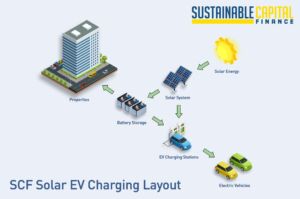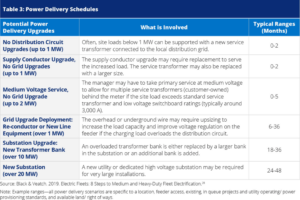As businesses seek to support the growing number of electric vehicles on the road, traditionally powered charging stations can be an inefficient solution for many types of businesses. While the addition of EV charging stations without a solar+storage component can still be highly beneficial for entities such as corporate offices and non-profits, solar+storage+EV charging microgrids may be the only financially viable option for businesses such as gas stations and commercial trucking depots.
What is a Solar Microgrid?
As opposed to a typical solar power system, a solar microgrid has the ability of operating independently from the central grid. This can be incredibly beneficial for customers in areas of high risk from natural disasters such as wildfires or hurricanes.
Although solar microgrids remain connected to the main grid throughout regular use, they come fitted with monitoring software that can detect any disruptions to the grid and disconnect when needed, providing solar energy either directly from the attached arrays or from the attached battery storage.
 Microgrids & EV Charging
Microgrids & EV Charging
While solar+storage alone can be highly beneficial for many off-takers, the benefits of a solar microgrid are amplified when EV charging is added to the mix. Fast charging station microgrids typically consist of several high-power electric vehicle charging stations, a local solar PV system, and an attached energy storage solution. These EV microgrids provide the ability to charge vehicles during peak times, reducing grid demand as well as electricity prices.
“The microgrid is able to meet the electric vehicle’s load demand on its own, reducing the overall cost,” wrote INL researcher Anudeep Medam, heading the lab’s Fast Charging Station Microgrids project. “And importantly, the microgrid can relieve congestion on the grid because the electric vehicles are charged from on-site resources. Another large benefit is that the charging is done with clean energy, reducing the carbon footprint.”
EV Charging Microgrids for Fleet Electrification
Due to the increasing financial and environmental benefits of electric transportation, a growing number of commercial fleet owners are looking to EVs as a means of long-term cost reduction. The increased load from an electrified commercial fleet can threaten to surpass local infrastructure capacity, however, resulting in expensive network upgrades and lengthy lead times for utility upgrades as shown below.
 Fleet owners are also at risk of being moved into a new rate class after fleet electrification, which could result in higher demand charges and other billing impacts. This is where combined solutions such as solar+storage+EV charging microgrids can provide easy solutions to these potential issues.
Fleet owners are also at risk of being moved into a new rate class after fleet electrification, which could result in higher demand charges and other billing impacts. This is where combined solutions such as solar+storage+EV charging microgrids can provide easy solutions to these potential issues.
As John Glassmire, of Grid Edge Solutions, writes:
“Electric vehicles are this amazing opportunity for utilities because it allows them to sell more electricity, but it’s also a challenge for them, because it changes how they’ve been delivering it and the way that power will flow through their lines—and you pair that up with things like the deployment of solar PV and distributed renewables that create this magic storm where you’re going to want to be considering these technologies to ensure that you have the adequate reliability and independence to achieve your energy goals.”
SCF & EV Charging Microgrids
SCF and its developer & EPC partner network can provide a number of competitive solar, storage and EV charging offerings, including microgrid options for those interested in a complete solution.
If you or your customers are interested in exploring a solar EV charging microgrid solution, you can schedule a quick check-in on our team’s calendar here.

